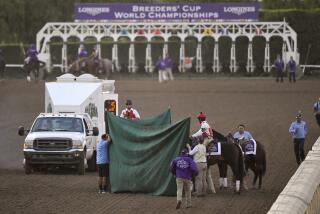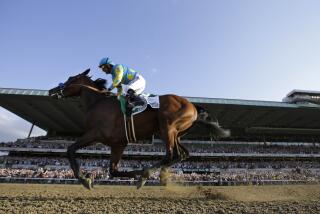Phar Lap’s Legend Lives On in Australia
- Share via
SYDNEY, Australia — Earlier this year, I was showing an Australian visitor the main attractions of Washington, D.C., and took him, of course, to the Lincoln Memorial. I said that Lincoln was the most universally revered figure in our nation’s history, and asked him who would have a comparable stature in Australia.
The visitor didn’t hesitate: “Phar Lap.”
Indeed, there do seem to be more monuments in Australia to the legendary racehorse of the 1930s than to any of the country’s founders. His statue graces the entrance to Flemington Race Course, site of the Melbourne Cup. The original Phar Lap was stuffed by a taxidermist and is on display at a museum in Melbourne, where it is a major tourist attraction. His heart has been preserved under glass at the Australian Institute of Anatomy in Canberra. (Naturally, it’s a gigantic heart.)
Moreover, the death of the champion--after an ill-fated trip to North America--still is a nettlesome issue here. On my first day in this country, the taxi driver from the airport recognized my accent and talked at length about how Aussies love Americans, how they’ve never forgotten that we were allies in World War II, but added one small proviso: “We’ll never forgive you for killing Phar Lap.”
No great racehorse has ever had a career so melodramatic. Phar Lap was bred in New Zealand and entered in a yearling sale there. A scuffling Australian trainer, Harry Telford, loved his pedigree, and persuaded an owner named David J. Davis to make the purchase.
When Phap Lap arrived from New Zealand after a rough crossing of the Tasman Sea, skin had been torn off his head and he limped out of the tight quarters he had occupied on ship. Davis didn’t want him, and so he leased him to Telford for three years--an agreement that would prove to be fateful.
Phar Lap--the name means “lightning” in Sinhalese, the major language of Sri Lanka--was slow to bloom, but he won his last nine races as a 3-year-old and was a popular champion by the time he was 4 and was preparing for the Melbourne Cup. Bookmakers stood to lose hundreds of thousands of dollars if he won.
His groom, Tommy Woodcock, recalled the events of that week in a film interview made shortly before his death a few years ago: “Mr. Telford got several letters that they were going to shoot him or run him down in the road. One morning we were going from the racetrack back to the stable and I happened to see this car on the road. The car started, and I took Phar Lap to the corner and pushed him to the fence. The car comes whizzing around the corner and all of a sudden a gun comes out the back window and fires a couple shots. They missed by a couple feet.”
After that close call, Phap Lap went into hiding before the Cup and arrived at Flemington under police escort 40 minutes before post time. The crowd roared at his arrival, and roared even louder after he carried 138 pounds to victory in the two-mile race.
Despite being burdened by crushing weights, Phar Lap won 15 of 17 races as a 4-year-old. As a 5-year-old, he won nine of 10.
By then, Telford’s three-year lease had expired, Davis was in charge and he chose to accept an invitation the trainer wanted to decline: to run in a stakes race at the Agua Caliente track in Tijuana, Mexico, just south of San Diego, for the then-incredible purse of $100,000.
Woodcock went with him on the ghastly ocean trip, but Phar Lap weathered it well enough that he was able to win the Caliente Handicap in track-record time, beating some of the best horses in North America. Now he was an international hero -- American newspapers hailed him as the “Red Terror from the Antipodes” -- and Davis was planning on running him in the United States, then in England.
Phar Lap, of course, never got that chance. Woodcock was looking after him in Menlo Park, Calif., where, he said: “Early one morning he got a little sick -- just a little temperature -- but by the next day he was in terrible pain. It was pitiful really, all the squealing and the pain he was in. I led him into the box (his stall) and he let out one unmerciful squeal and died in my arms.”
The next day, flags in Australia were flying at half-mast, and headlines in newspapers said simply: “HE’S DEAD.”
Who or what killed Phar Lap? After the earlier attempts on his life, Australians were naturally conspiracy-minded, and a Melbourne reporter who accompanied him on his North American trip reported he was killed by poisoned balls of clay that were thrown through the window of his stall.
The truth probably was much less dramatic. Isobel Carter, Phar Lap’s principal biographer, researched the whole issue in depth and concluded that the horse had eaten “highly fermentable green pasture” that caused his stomach to swell and brought on a fatal attack of colic.
The mysterious circumstances only added to the Phar Lap legend.
“He came along in the Depression years and he was a symbol of hope and optimism,” said Gary Gray, who conducted the Tommy Woodcock interview and has produced films on Australian racing history here. “He also told the world that we could produce horses to beat the best, and we could do a whole lot of other things too. We were not just a colony. Phar Lap was a symbol of our emergence as a nation.”
More to Read
Sign up for The Wild
We’ll help you find the best places to hike, bike and run, as well as the perfect silent spots for meditation and yoga.
You may occasionally receive promotional content from the Los Angeles Times.






